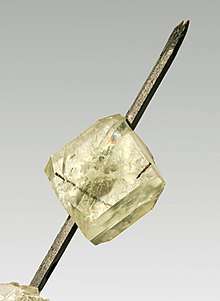Leucophanite
| Leucophanite | |
|---|---|
 The leucophanite on an aegirine needle (about 4-5 mm on edge) | |
| General | |
| Category | Inosilicates |
| Formula (repeating unit) | (Na,Ca)2BeSi2(O.OH.F)7 |
| Strunz classification | 9.DH.05 |
| Crystal system | Orthorhombic |
| Crystal class |
Disphenoidal (222) (same H-M symbol) |
| Space group | P212121 |
| Identification | |
| References | [1][2][3][4][5] |
Leucophanite is an inosilicate mineral with a complex composition, (Na,Ca)2BeSi2(O.OH.F)7. It may contain cerium substituting in the calcium position.
It occurs in pegmatites and alkali igneous complexes as yellow, greenish or white triclinic crystals and has been found in Norway, Quebec and Russia.
It was first described from the Langesundfiord district of southern Norway in 1840. The name is from the Greek leucos for "white" and phanein for "to appear" in allusion to the common white color.
References
| Wikimedia Commons has media related to Leucophanite. |
This article is issued from
Wikipedia.
The text is licensed under Creative Commons - Attribution - Sharealike.
Additional terms may apply for the media files.